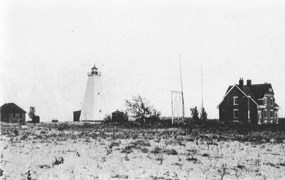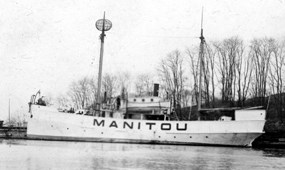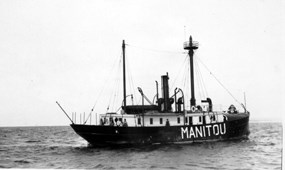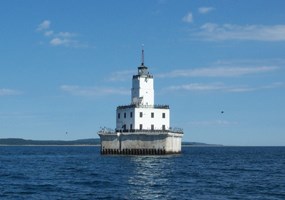
NPS/Mark Lindsey South Manitou Island LighthouseThe South Manitou Island Lighthouse is the most familiar landmark on the island and is clearly visible from the mainland. The 100 foot lighthouse tower, active from 1871 to 1958, marked the location of the only natural harbor between here and Chicago. Ships took refuge here during storms and steamers stopped at the island to refuel with wood for their boilers. The keeper's quarters (building on the right) is connected by a covered passage. 
David Petersen, http://blackcreekpress.com North Manitou Island LighthouseThe North Manitou Island Light is no longer standing. It began to be built in 1896 including a keeper's dwelling and fog signal house. A simple, steel frame skeleton tower was erected in 1898. The tower's Fourth Order Fresnel lens, with alternating red and white lights, together with the beacon of South Manitou Island, guided ships through the narrow two-mile passage. 
David Petersen http://blackcreekpress.com 
David Petersen, http://blackcreekpress.com Lightship No. 89 assumed the vigil in 1927 and was evenutally replaced by the permanent, radar-based steel-framed structure that today lights the way through this hazardous area. 
North Manitou Shoal Light (Crib)The North Manitou Shoal Light is not within the Lakeshore, but it is easily seen from the mainland near Glen Haven. You can also get a close-up look at it during the ferry ride. It was constructed in 1935 to prevent ships from running into danger on the North Manitou Shoals, which extend several miles into the passage between the islands and Leelanau Peninsula. This automated light built on a square concrete crib in 26 feet of water made the South Manitou station obsolete. The lighthouse was equipped with a 4-sided Fresnel lens. When the facility was updated and automated in 1980, the big lens was removed and placed on permanent display in the Glen Haven Cannery Boat Museum. For forty-two years, the crib was home to a three man coast guard crew, who lived in the light tower building. Crew members rotated on a three-week schedule: 2 weeks on and 1 week off. The Passage was a busy place during that time with a wide variety of vessels passing each day. The mail boat stopped on a fairly regular schedule and boats from the local coast guard stations were also frequent visitors. The last crew left in 1980 when the facility was fully automated. Today it is home to a colony of double-crested cormorants, which may be doing more damage to the facility than any other natural force. The lighthouse remains fully functional and is maintained by the Coast Guard ATON (Aids to Navigation Team). A red light atop its 63-foot tower flashes on 15 second intervals, it's fog horn sounds on 20 second cycles when conditions require, and a RACON (radar transponder beacon) imposes a Morse code character "N" on the radar screen of passing ships. The coast guard has excessed this facility. It has become available under the Historic Lighthouse Preservation Act of 2000. The facility can be leased or transferred to some other eligible entity with the government retaining access rights for as long as its navigation aids are needed. The North Manitou Shoal Light Preservation Society (NMSLPS) has been formed to investigate options for preservation of the Crib. The lighthouse was equipped with a 4-sided Fresnel lens. When the facility was updated and automated in 1980, the big lense was removed and placed on permanent display in the Glen Haven Cannery Boat Museum. For forty-two years, "the crib" was home to a three man Coast Guard crew, who lived in the light tower building. Crewmembers rotated on a three-week schedule: 2 weeks on and 1 week off. The Passage was a busy place during that time with a wide variety of vessels passing each day. The mail boat stopped on a fairly regular schedule and boats from the local Coast Guard stations were also frequent visitors. The last crew left in 1980 when the facility was fully automated. Today it is home to a colony of Double-Crested Cormorants, which may be doing more damage to the facility than any other natural force. The lighthouse remains fully functional and is maintained by the Coast Guard ATON (Aids to Navigation" Team. A red light atop its 63 foot tower flashes on 15 second intervals, it's fog horn sounds on 20 second cycles when conditions require, and a RACON (radar transponder beacon) imposes a Morse code character "N" on the radar screen of passing ships. The Coast Guard has "excessed" this facility. It has become available under the "Historic Lighthouse Preservation Act of 2000". The facility can be leased or transferred to some other eligible entity with the government retaining access rights for as long as its navigation aids are needed. The North Manitou Shoal Light Preservation Society (NMSLPS) has been formed to investigate options for preservation of the Crib. |
Last updated: September 7, 2024
